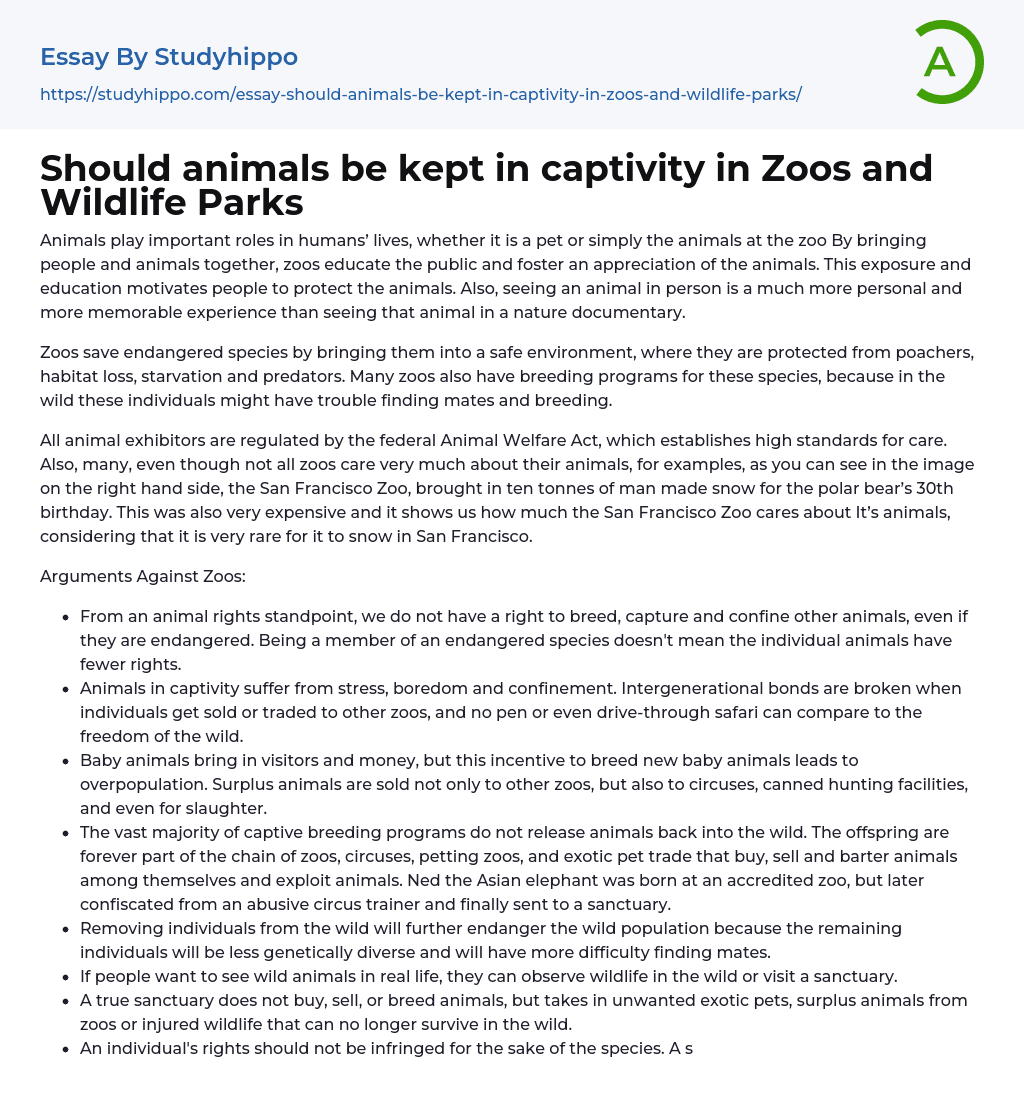

Should animals be kept in captivity in Zoos and Wildlife Parks Essay Example
Animals play important roles in humans’ lives, whether it is a pet or simply the animals at the zoo By bringing people and animals together, zoos educate the public and foster an appreciation of the animals. This exposure and education motivates people to protect the animals. Also, seeing an animal in person is a much more personal and more memorable experience than seeing that animal in a nature documentary.
Zoos save endangered species by bringing them into a safe environment, where they are protected from poachers, habitat loss, starvation and predators. Many zoos also have breeding programs for these species, because in the wild these individuals might have trouble finding mates and breeding.
All animal exhibitors are regulated by the federal Animal Welfare Act, which establishes high standards for
...care. Also, many, even though not all zoos care very much about their animals, for examples, as you can see in the image on the right hand side, the San Francisco Zoo, brought in ten tonnes of man made snow for the polar bear’s 30th birthday. This was also very expensive and it shows us how much the San Francisco Zoo cares about It’s animals, considering that it is very rare for it to snow in San Francisco.
Arguments Against Zoos:
- From an animal rights standpoint, we do not have a right to breed, capture and confine other animals, even if they are endangered. Being a member of an endangered species doesn't mean the individual animals have fewer rights.
- Animals in captivity suffer from stress, boredom and confinement. Intergenerational bonds are broken when individuals get sold or
traded to other zoos, and no pen or even drive-through safari can compare to the freedom of the wild.
as elephants in the wild.
They didn’t think of the wild animals habitat, and there are some problems arise from keeping them in cages. The shock of being in captivity would depress the animals; they would even act hysterically and might hurt people near them. And it is not the animal to be fault. There are three main reasons why wild animals should not
be kept in the zoos: Firstly, the ecosystem became unbalanced. If the humans kept the wild animals in the zoo, they will ruin the food chain. For instance, plants are provided by the nature, being eaten by the reindeers then the tigers hunt reindeers for their food. If the tigers were being captured by the humans and kept in cages, we humans instantly break the chain. And the consequences are we going to have a dramatic increase in reindeer’s population and more plants are being consumed. (Tutorvista, 2010) Secondly, the lack of freedom and space in the zoo.
Animals were being kept in cramped and small cages. Even though they were made similar to the animal’s natural environment, but still it is different. Tigers need to run a lot, but kept in the zoo where it is lack of spacious area. They need to hunt for their own food, however while in the zoo the foods are provided. There is no freedom for the animals for being kept by humans. Worst case possible is animals would get depressed and attack people randomly. People should not blame the animals if they got attacked; it is their own fault for keeping the animals in cages.
- Rabbit essays
- Distribution essays
- Large Animals essays
- Mouse essays
- Poultry essays
- Animal Abuse essays
- Cats Vs Dogs essays
- Cattle essays
- Territory essays
- Animal Welfare essays
- Climate Change essays
- Conservation essays
- Global Warming essays
- Plastic essays
- Recycling essays
- Waste Management essays
- Zoo essays
- Agriculture essays
- Albert einstein essays
- Animals essays
- Archaeology essays
- Bear essays
- Biology essays
- Birds essays
- Butterfly essays
- Cat essays
- Charles Darwin essays
- Chemistry essays
- Dinosaur essays
- Discovery essays
- Dolphin essays
- Elephant essays
- Eli Whitney essays
- Environmental Science essays
- Evolution essays
- Fish essays
- Genetics essays
- Horse essays
- Human Evolution essays
- Isaac Newton essays
- Journal essays
- Linguistics essays
- Lion essays
- Logic essays
- Mars essays
- Methodology essays
- Mineralogy essays
- Monkey essays
- Moon essays
- Mythology essays



